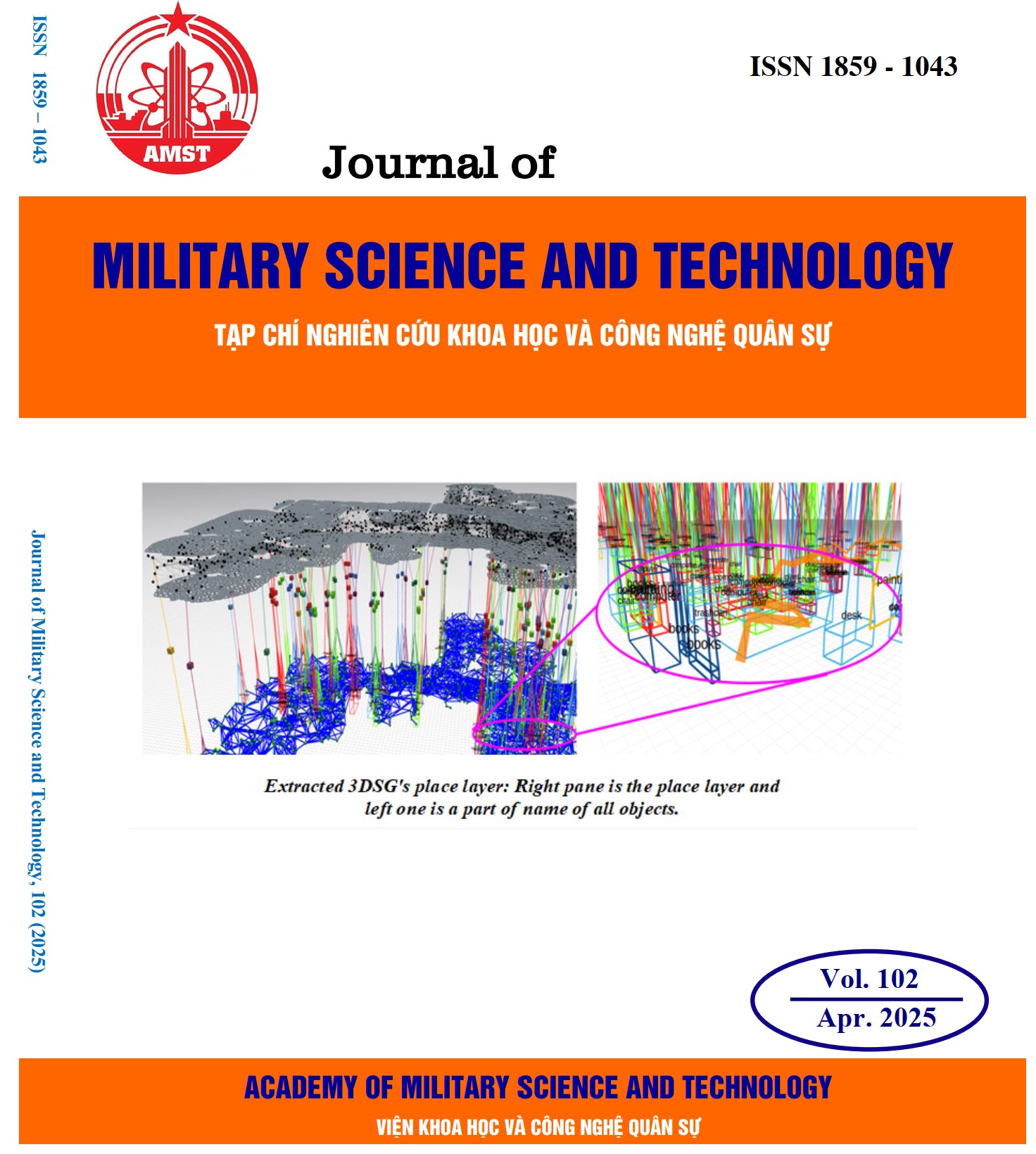Experimental research and evaluation of thermal camouflage effectiveness of advanced materials for mobile vehicles
606 viewsDOI:
https://doi.org/10.54939/1859-1043.j.mst.102.2025.109-117Keywords:
Camouflage; Thermal camouflage; Mobile vehicles; Emission energy; Gray level similarity.Abstract
Mobile vehicles, with high heat-generating engines and metallic outer shells known for their significant heat absorption and emission, are easily detected and identified by thermal imaging reconnaissance systems. To mitigate thermal contrast, a practical solution is to apply coatings capable of reducing thermal emissions from mobile vehicles. However, no domestic studies have yet evaluated the effectiveness of thermal camouflage coatings for such vehicles. This paper focuses on analyzing the composition of advanced coating materials, conducting experimental trials, and assessing their thermal camouflage effectiveness for mobile vehicles in Vietnam. The findings of this study serve as a foundation for developing new materials and effectively applying thermal camouflage to mobile vehicles in the country.
References
[1]. Watson K Geological, “Application of Thermal Infrared Images”, Proceeding of the IEEE, 63: 128~137, (1975). DOI: https://doi.org/10.1109/PROC.1975.9712
[2]. Liang F.R. et al, “Improving anti-infrared radiation and heat insulation by potassium hexatitanate whisker-doped A12O3-SiO2composite xerogel”, J.Royal Society Open Science, 12(5): 180787-180787, (2018). DOI: https://doi.org/10.1098/rsos.180787
[3]. N.T. Cam et al, “Camouflage in countering optical-electronic reconnaissance”, Training curriculum for postgraduate students of the Academy of Military Science and Technology, People's Army Publishing House (2023).
[4]. Meng Z.H. et al, “Research progress on photonic crystal infrared stealth materials technology”, J.Acta Armamentarii, 37(8): 1543-1552, (2016).
[5]. D. Peric et al, “Thermal Imager Range: Predictions, Expectations and Reality”, Sensor, 19(15), 3313, (2019). DOI: https://doi.org/10.3390/s19153313
[6]. C. Plesa et al, “The use of infrared radiation for thermal signatures determination of ground targets”, Rom. J. Phys. 51, pp.63–72, (2006).
[7]. J.G. Hixon et al, “Target detection cycle criteria when using the target task metric” SPIE 5612, pp. 275–276, (2004). DOI: https://doi.org/10.1117/12.577830
[8]. Zhang Weigang et al, “Preparation and characterization of Ge/TiO2 one-dimensional photonic crystal with low infrared-emissivity in the 8-14 um band”, J.Materials Research Bulletin, 124: 110747, (2020). DOI: https://doi.org/10.1016/j.materresbull.2019.110747
[9]. Liu Dongqing, “Application of variable infrared-emissivity materials to spacecraft thermal control”, Journal of National University of Defense Technology, 34(2): 145-149, (2012).
[10]. J. Berela, M. Kastek, “Measurement and Analysis of the Parameters of Modern Long-Range Thermal Imaging Cameras”, Sensor (17), 5700, (2021).
[11]. F.B. Olsen, “Methods for evaluating thermal camouflage”, A FFI Report No. RTO-MPSCI-145, 2005.
[12]. A. Roglski et al, “Infrared Detectors, An Overview”, Inf. Phys. Technol. 43, pp. 187-210, (2002). DOI: https://doi.org/10.1016/S1350-4495(02)00140-8
[13]. Eisner Leonard et al, “Spectral Radiation of Sky and Terrain Wavelength between 1 and 20 µm. Terrain Measurements”. Journal of the Optical Society of America, 52: 201~209, (1962). DOI: https://doi.org/10.1364/JOSA.52.000201
[14]. J. Berela, M. Kastek, “Measurement and Analysis of the Parameters of Modern Long-Range Thermal Imaging Cameras”, Sensor (17), 5700, (2021). DOI: https://doi.org/10.3390/s21175700
[15]. William L. Wolfe, “Handbook of Military Infrared Technology”, Office of Naval Research Department of the Navy, (1965).
[16]. N.N. Son et al, “A high-accuracy measurement method of surface emissivity using a spectroradiometer SR-5000N”, Proc. of 8th CASEAN, Vinh, pp.674, (2023).
[17]. M. Honner and P. Honnerová, “Survey of emissivity measurement by radiometric methods”, Appl. Opt. 54, 669-683 (2015). DOI: https://doi.org/10.1364/AO.54.000669







